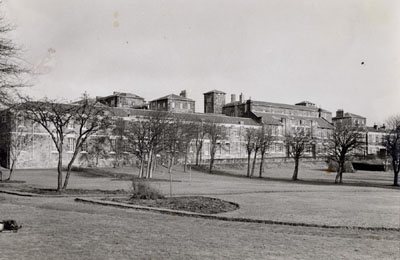
A view of the buildings and grounds at Foresthall Hospital from the main drive approaching the hospital, 1975. The buildings were erected as an extension to Barnhill Poorhouse in 1904, to provide extra staff accommodation and stables.
The 1904 extension also included the workhouse, sometimes referred to as the "test house". The suitability of applicants for relief was "tested" here - they were set to work at oakum picking, basket-weaving or some other monotonous or onerous task to "prove" they were deserving poor in desperate need for parochial assistance, and not malingerers or other undeserving cases. If they refused to work or proved "difficult", they might be shut up in a special single punishment cell.
The end of the poorhouse system came in 1930 with the repeal of the Poor Law Amendment Act, which had made the poorhouse the only legal source of relief. But it was only with the post-war reforms of the 1940s that the poor law was finally removed from the statute books. Barnhill Poorhouse became Foresthall Hospital in 1945. Under the less severe regime at Foresthall, the "test house" ceased to be a workhouse and was used instead as a venue for IQ tests.
Reference: Heatherbank Museum of Social Work, print 958
Reproduced with the permission of Glasgow Caledonian University, Research Collections, Heatherbank Museum of Social Work
Keywords:
Barnhill Poorhouse, Foresthall Home and Hospital, hospitals, paupers, Poor Law Amendment Act, poor relief, poorhouses, social welfare, stables, test houses, workhouses
You have 0 images in your photo album.